The ADATA FALCON is an M.2 SSD that is built around high performance, or “pro-formance” as they clumsily said. The drive comes in a fairly wide capacity range, 256GB up to 2TB. The M.2, 2280, form factor makes it a fit for desktops or notebooks. The main use cases for the ADATA FALCON are photo editing, industrial drawing, and programming.
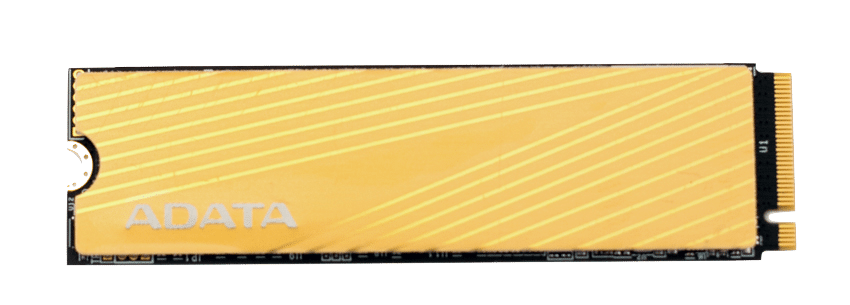
The drive is said to be built around performance with quoted speeds of 3.1GB/s read and 1.5GB/s write and a 180K IOPS throughput. The drive leverages the PCIe Gen3x4 (NVMe 1.3) interface to as well as SLC caching, and Host Memory Buffer to hit these high numbers. The drive comes with a pretty nifty aluminum alloy heatsink to keep it cool and stable.
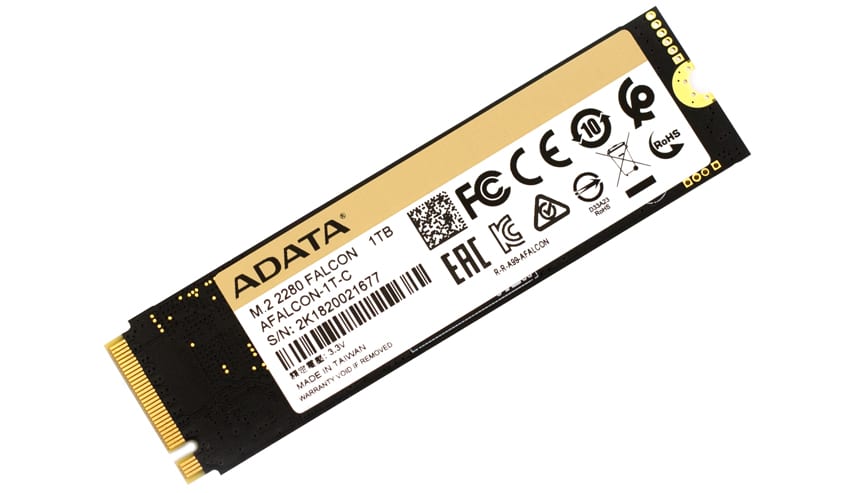
The ADATA FALCON comes with a 5-year warranty. The drive is priced at $55, $70, $130, and $240 for the 256GB, 512GB, 1TB, and 2TB respectively.
ADATA FALCON Specifications
| Capacity | 256GB / 512GB / 1TB / 2TB |
| Form Factor | M.2 2280 |
| NAND Flash | 3D NAND |
| Dimensions (L x W x H) | 80 x 22 x 2.9mm |
| Weight | 9g |
| Interface | PCIe Gen3x4 |
| Sequential Read (Max) | Up to 3100MB/s |
| Sequential Write (Max) | Up to 1500MB/s |
| 4KB Random Read IOPS(Max) | Up to 180K |
| 4KB Random Write IOPS(Max) | Up to 180K |
| Operating Temperature | 0°C – 70°C |
| Storage Temperature | -40°C – 85°C |
| Shock Resistance | 1500G/0.5ms |
| MTBF | 1,800,000 hours |
| Terabytes Written (TBW)(Max Capacity) | 1,200TB |
| Warranty | 5-year limited warranty |
Performance
Testbed
The test platform leveraged in these tests is a Dell PowerEdge R740xd server. We measure SATA performance through a Dell H730P RAID card inside this server, although we set the card in HBA mode only to disable the impact of RAID card cache. NVMe is tested natively through an M.2 to PCIe adapter card. The methodology used better reflects end-user workflow with the consistency, scalability and flexibility testing within virtualized server offers. A large focus is put on drive latency across the entire load range of the drive, not just at the smallest QD1 (Queue-Depth 1) levels. We do this because many of the common consumer benchmarks don’t adequately capture end-user workload profiles.
Houdini by SideFX
The Houdini test is specifically designed to evaluate storage performance as it relates to CGI rendering. The test bed for this application is a variant of the core Dell PowerEdge R740xd server type we use in the lab with dual Intel 6130 CPUs and 64GB DRAM. In this case, we installed Ubuntu Desktop (ubuntu-16.04.3-desktop-amd64) running bare metal. Output of the benchmark is measured in seconds to complete, with fewer being better.
The Maelstrom demo represents a section of the rendering pipeline that highlights the performance capabilities of storage by demonstrating its ability to effectively use the swap file as a form of extended memory. The test does not write out the result data or process the points in order to isolate the wall-time effect of the latency impact to the underlying storage component. The test itself is composed of five phases, three of which we run as part of the benchmark, which are as follows:
- Loads packed points from disk. This is the time to read from disk. This is single-threaded, which may limit overall throughput.
- Unpacks the points into a single flat array in order to allow them to be processed. If the points do not have dependency on other points, the working set could be adjusted to stay in-core. This step is multi-threaded.
- (Not Run) Processes the points.
- Repacks them into bucketed blocks suitable for storing back to disk. This step is multi-threaded.
- (Not Run) Writes the bucketed blocks back out to disk.
Here, we see the FALCON hit 3,346.7 seconds placing it near the bottom but still ahead of six other drives.
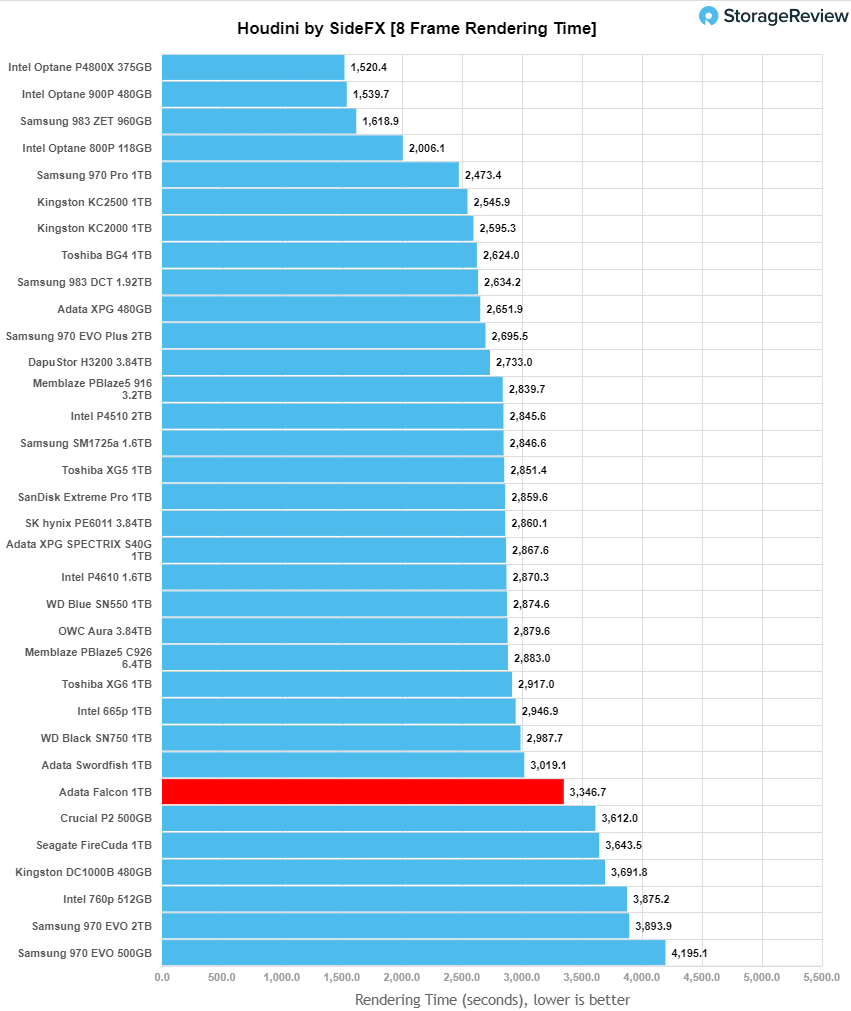
VDBench Workload Analysis
When it comes to benchmarking storage devices, application testing is best, and synthetic testing comes in second place. While not a perfect representation of actual workloads, synthetic tests do help to baseline storage devices with a repeatability factor that makes it easy to do apples-to-apples comparison between competing solutions. These workloads offer a range of different testing profiles ranging from “four corners” tests, common database transfer size tests, to trace captures from different VDI environments. All of these tests leverage the common vdBench workload generator, with a scripting engine to automate and capture results over a large compute testing cluster. This allows us to repeat the same workloads across a wide range of storage devices, including flash arrays and individual storage devices. Our testing process for these benchmarks fills the entire drive surface with data, then partitions a drive section equal to 5% of the drive capacity to simulate how the drive might respond to application workloads. This is different than full entropy tests which use 100% of the drive and take them into steady state. As a result, these figures will reflect higher-sustained write speeds.
Profiles:
- 4K Random Read: 100% Read, 128 threads, 0-120% iorate
- 4K Random Write: 100% Write, 64 threads, 0-120% iorate
- 64K Sequential Read: 100% Read, 16 threads, 0-120% iorate
- 64K Sequential Write: 100% Write, 8 threads, 0-120% iorate
Comparables for this review:
- ADATA SWORDFISH 1TB
- WD Blue SN550 1TB
- Samsung EVO Plus 2TB
- Kingston KC2500 1TB
- WD Black 1TB
- Seagate FireCuda 510 1TB
For 4K random read performance, the ADATA FALCON came up in the back of the pack with a peak performance of only 26,196 IOPS at a latency of 674.4µs.
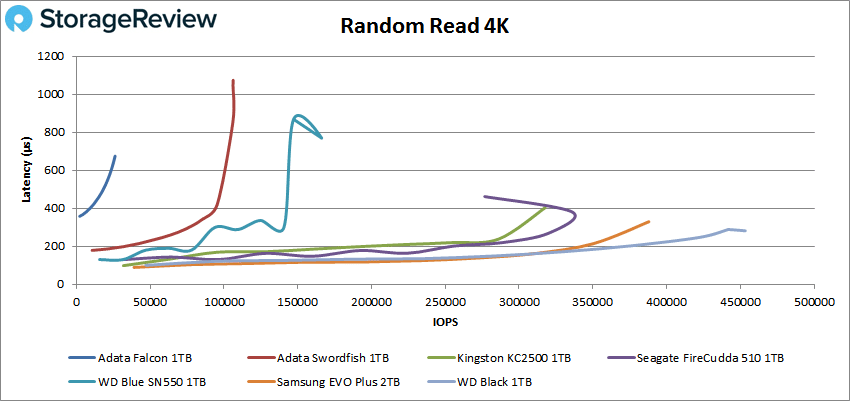
Looking next to 4K random write performance the FALCON was able to beat out the SWORDFISH only as it peaked at 12,408 IOPS at 10.3ms for latency.
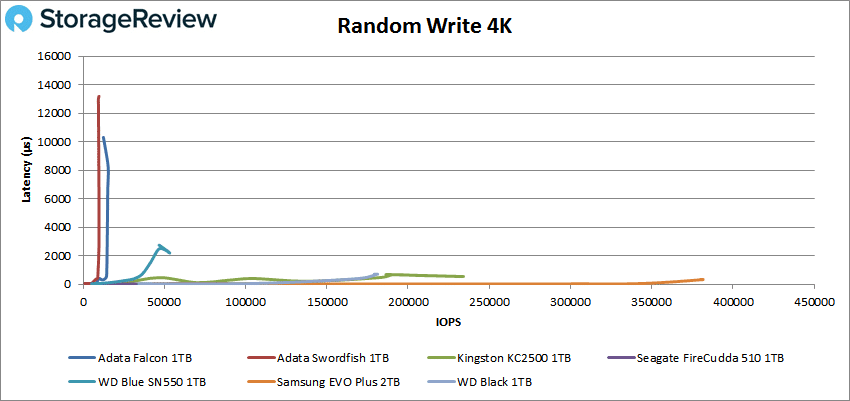
Flipping over to sequential work, the FALCON came in last again in 64K read with a peak of 16,315 IOPS or 1.03GB/s at a latency of 967µs.
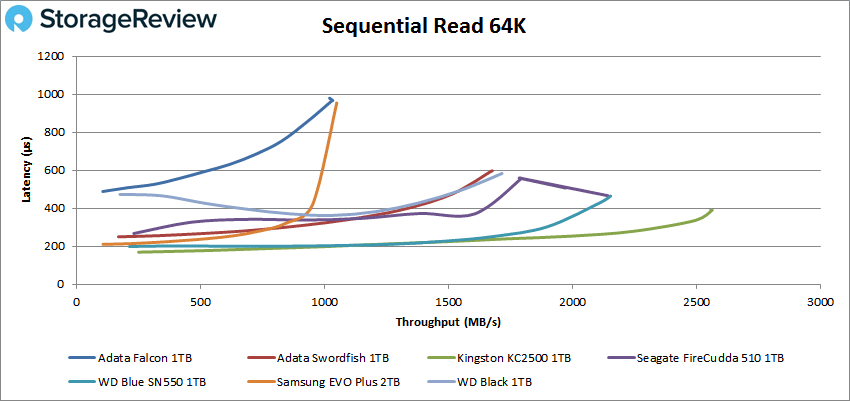
64K write saw slightly better placing, second to last, with a peak score of about 3,500 IOPS or about 220MB/s at a latency of 4.5ms before dropping off in performance and shooting up in latency.
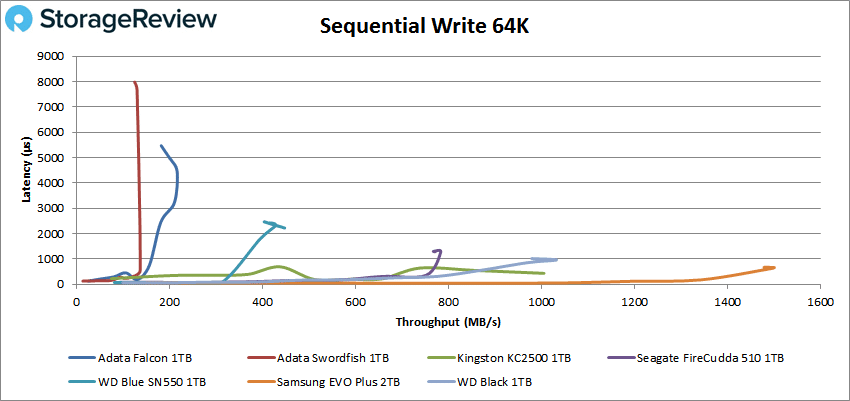
Next, we looked at our VDI benchmarks, which are designed to tax the drives even further. Here you can obviously see that all of these drives struggled, though this was expected due to their focus on price point and read performance only. These tests include Boot, Initial Login, and Monday Login. That said, the Boot test showed the FALCON to be in last, yet again, at a peak of 15,119 IOPS at a latency of 2.22ms before dropping off.
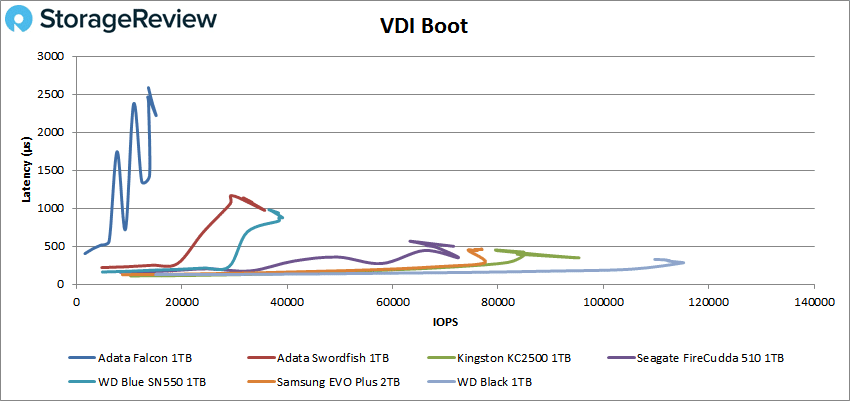
VDI Initial Login gets a bit harder to read but here the FALCON peaked at 9,396 IOPS at a latency of 3.2ms.
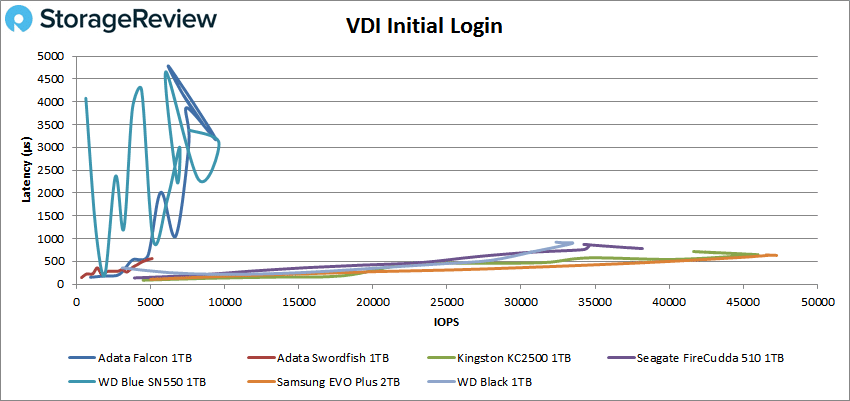
Finally, the VDI Monday Login had the FALCON place last again with a peak score of 3,097 IOPS at a latency of 404µs after coming down from a larger peak.
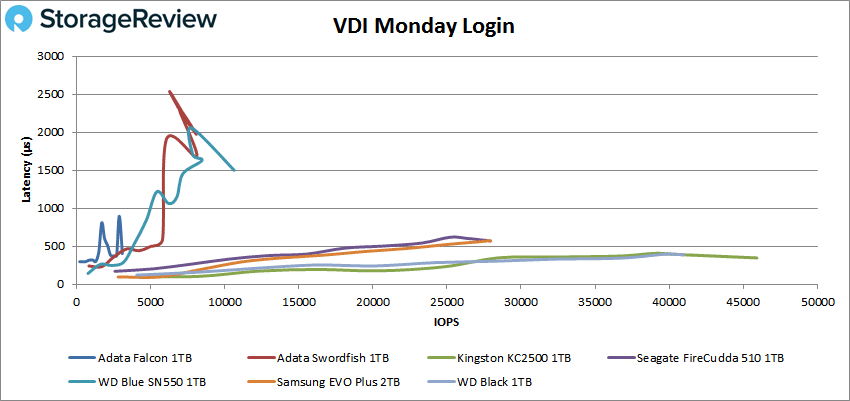
Conclusion
The ADATA FALCON is the company’s “pro-formance” M.2 NVMe SSD. The drive comes in capacities up to 2TB and has quoted speeds of upward of 3.1GB/s and 180K IOPS throughput. The drive supports LDPC (Low-Density Parity-Check) error correcting code technology to detect and fix errors along the way. And on the security side, the drive uses AES 256-bit encryption.
For performance we ran our usual barrage of test and have to say, the results are underwhelming. For Houdini the drive hit 3,346.7 seconds, which isn’t terrible but also at the bottom of the group. In our VDBench Workload Analysis, the drive kept slipping above 1ms (sometimes over 10ms) and stayed in last or second to last throughout. 4K read saw it peak at 26K IOPS, 12K for 4K write, 1.03GB/s for 64K read, and 220MB/s for 64K write. Switching over to VDI benchmarks didn’t see an improvement in placement with the FALCON peaking at 15K IOPS in boot, 9K IOPS in Initial Login, and 3K IOPS in Monday Login. The performance overall looked more like how a QLC SSD acts under these conditions than a TLC-based drive.
The ADATA FALCON has lackluster performance but is fairly inexpensive. If one is looking for a little more of a performance punch, there are several options out there, but for the right price this drive may be useful for limited use.




 Amazon
Amazon